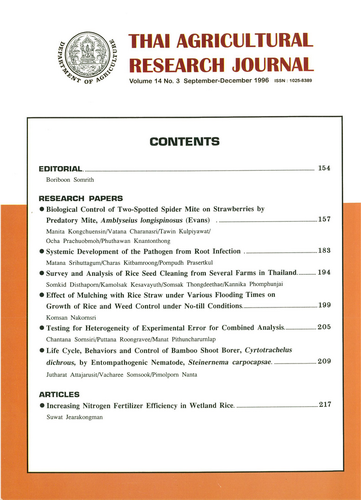Survey and Analysis of Rice Seed Cleaning from Several Farms in Thailand
DOI:
https://doi.org/10.14456/thaidoa-agres.1996.19Keywords:
pathogenic fungi, rice seedAbstract
Two hundrea and seventy rice seed samples (2.5 kgs/sample with 30 samples/province) were collected from farmers in 9 provinces; Chiang Mai and chiang Rai representative of the North, Nakon Retchasima and Udon Thani of the North-East, Chacheongsao, Supan Buri and Chai Nat of the Central, and Nakhon Si Thammarat and Phathalung of the South. To assess current on-farm seed management practices in rice production, the farmers, seed owners were individually interviewed at the same visit. Results of farmer perceptions and practices had been summarised in the text. The impact evidence indicated that most of the farmers prefer to change their rice-growing varieties every 2-3 years because they could not keep a stability of rice variety quality after continuous used over 5 seasonal crops. It is noted that farmers mainly use government recommended varieties at 78.97% combine with local and traditional varieties at 11.07% and 9.96% respectively. Collected seed samples were then sent to laboratories to analyse and assess their contaminants. Among the pathogenic fungi found on seed. Alternaria padwickii and Curvularia lanata were the major contaminants which mainly observed in the Central region. Bacteria, Xamthomonas sp. and Pseudomonas sp. were also slightly found, rice seed with red pericarp Oryzae spp. so called "red rice" was the major contaminant commonly mixed-in a high level of 55% followed by seeds of weeds Ishaemum rugosum, Echinochloa calona and E. crus-galli at 33.35%, 21.41% and 14.97% respectively. All seed samples were below the standard seed quality for growing purpose.
Downloads
Published
How to Cite
Issue
Section
License

This work is licensed under a Creative Commons Attribution-NonCommercial-NoDerivatives 4.0 International License.
Thai Agricultural Research Journal



